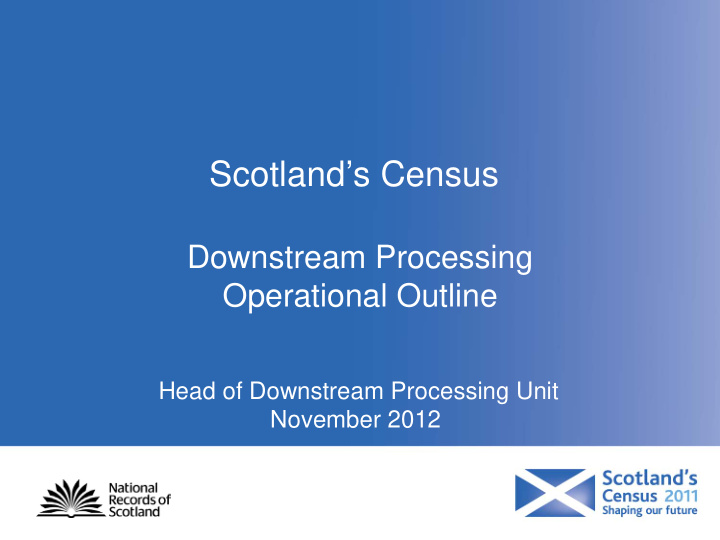



Scotland’s Census Downstream Processing Operational Outline Head of Downstream Processing Unit November 2012
Overview Census taken on 27 March 2011 Roughly 80% paper returns, 20% internet. To arrive at a population figure we: – Capture and clean the data – Impute missing characteristics – Estimate the returns we didn’t get – Derive variables for output – Assign output areas – Apply Disclosure Controls
Flow of data Load & Remove False Capture data Validation persons Resolve Multiple Filter Rules Imputation Responses Estimate Impute skeleton Assign output missing returns records areas Derive variables Disclosure Outputs for output Control database
Development of methods Developed in close consultation with Office for National Statistics (ONS), Welsh Assembly Government (WAG) and Northern Ireland Statistics and Research Agency (NISRA) Allows harmonised outputs Implementation by National Records of Scotland (NRS), but making use of ONS algorithms and code where possible Benefits & Issues
Capture and Coding Scanning / Operators – All tick boxes and text fields captured as text – Questionnaires guillotined and scanned – Hundreds of operators – Questionable fields flagged to operators – Quality assurance samples drawn and checked
Data Cleaning – Initial Validation Load and Validation – right types of values/ranges etc – Check data received as expected – Load into Small Area Statistics (SAS) database – Referential integrity – Range checks Remove false Persons – (2 of 6 rule) – Occur due to: crossings out/mistakes or dust on scanner – Reject person records without a response to at least 2 of: • name • sex • marital/civil partnership status • date of birth
Data Cleaning – Multiple Responses Can occur due to: – Internet & paper returns from same household – Two paper returns from same household – person filling in details twice – person on both household and individual forms Identify which case then – Decide which is ‘best’ response (rules) – merge data where appropriate
Data Cleaning – Filter rules Not everyone should answer every question, e.g.own accommodation (skip landlord question), born in UK (skip date of arrival) under 16 (skip employment questions) Resolve inconsistent responses Deterministic Which response do we believe?
Imputation (1) Some records have missing/inconsistent data Probabilistic approach Missing and inconsistent responses Requires complex relationships between members of the household to be analysed – triangulation of relationships
Imputation (2) CANCEIS – Canadian Census Edit and Imputation Software Donor imputation Minimum change Decision Logic Tables (DLT) Deterministic edits?
Coverage matching and estimation Missing households and people Census Coverage Survey (CCS) Match Census and CCS records - automatic and clerical Dual systems estimation Regression estimator Age-sex groups by local authority Overcount? Estimates quality assured against admin sources
Coverage adjustment Produce consistent individual level database Add missed households and individuals Use known gaps where possible Maintain consistency with surrounding area ‘Skeleton records’
Post-Coverage Imputation We need to fill out realistic characteristics for the skeleton records Again using Canadian Census Edit and Imputation Software (CANCEIS) and preserving variable distributions
Derive complex variables Remaining variables for outputs, e.g. - household composition algorithm - dwellings - occupation - industry
Output area creation Lowest geographical level of unrestricted data release Working on a principle of minimum change from 2001 Working closely with National Records of Scotland (NRS) Geography
Disclosure control Protect individual-level data by introducing uncertainty Assuming pre-tabular either over-imputation or record swapping Level to be decided (and not made public) Balance between protection and utility
Flow of data Load & Remove False Capture data Validation persons Resolve Multiple Filter Rules Imputation Responses Estimate Impute skeleton Assign output missing returns records areas Derive variables Disclosure Outputs for output Control database
Publication and Dissemination Phased releases Increasing detail Thematic outputs etc
Thank you
Recommend
More recommend